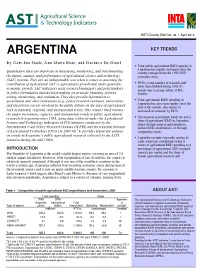Authors:
Gert-Jan Stads, Ana María Ruiz, and Gustavo De Greef
Year:
2010
Publisher
IFPRI-ASTI
Back to:
Total public agricultural R&D capacity in Argentina has rapidly increased since the country emerged from the 1999-2002 economic crisis. This increase is mainly due to strong growth in INTA’s researcher totals, which rose from 1,180 FTEs in 2004 to 2,410 in 2007 following a large injection of national government and IDB funds in support of agricultural R&D. It should be noted, however, that most of INTA’s recently hired researchers hold BSc degrees. In 2006, the country as a whole employed close to 4,000 FTE agricultural research staff, making it the third largest agricultural R&D system in Latin America after Brazil and Mexico.
Total agricultural R&D spending in Argentina has also risen rapidly since the turn of the century, due mainly to increased investments by INTA. In 2006, Argentina spent $448 million (in 2005 PPP prices), compared to $296 million two years earlier. Over the course of the past 15 years, INTA has gone from being a poorly funded institute on the verge of being closed down to a well-functioning and well-funded institute producing worldclass research. Agricultural R&D in Argentina has become increasingly demand driven, it is increasingly funded through competitive schemes, and it has played a key role in stepping up the country’s agricultural production and exports over the past decade. The country occupies top ranks among its Latin American counterparts when it comes to agricultural R&D spending as a percentage of agricultural GDP, research capacity per capita, and the share of female agricultural research staff. Sustainable funding for agricultural R&D is key to ensuring that the extraordinary advances that the country has made over the past decade are not eroded in the future.

